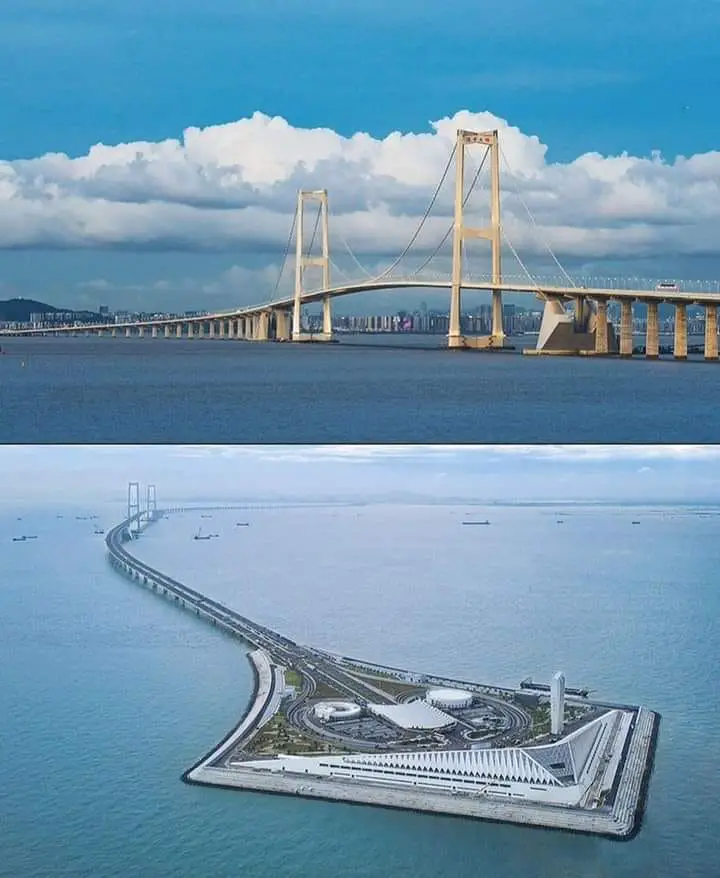The Shenzhen–Zhongshan Link is a groundbreaking infrastructure project that epitomizes China’s commitment to engineering excellence and regional connectivity. Stretching across 50 kilometers, this ambitious bridge-tunnel system links two major cities in the Pearl River Delta (PRD): Shenzhen on the eastern side and Zhongshan on the western side. By facilitating seamless travel across the PRD, the project not only reduces travel time but also enhances economic integration within one of the world’s most dynamic urban clusters.

Strategic Importance of the Pearl River Delta
The Pearl River Delta is a vital economic hub in southern China, housing some of the country’s most industrious cities. Shenzhen, known globally as a technology and innovation powerhouse, and Zhongshan, an industrial and cultural city, are two key players in this region. Prior to the Shenzhen–Zhongshan Link, connectivity between the two cities was reliant on ferry services or a longer detour via the Humen Bridge. This created bottlenecks, hampering both daily commutes and the transportation of goods.
The Shenzhen–Zhongshan Link was conceived as a solution to these challenges, aiming to foster regional collaboration, boost trade, and promote economic growth across the PRD.
Design and Structure: A Blend of Engineering Ingenuity
The Shenzhen–Zhongshan Link is a state-of-the-art combination of bridges, tunnels, and artificial islands, making it one of the most complex engineering projects in the world. It consists of three main components:
- The Shenzhen–Zhongshan Tunnel:
A pivotal section of the link, this underwater tunnel spans 6.8 kilometers, allowing ships to navigate the Pearl River without obstruction. The tunnel’s construction involved advanced immersed-tube technology to ensure durability and safety in a region prone to typhoons. - The Shenzhen–Zhongshan Bridge:
This expansive bridge spans a significant portion of the link, featuring cable-stayed and suspension designs to withstand heavy traffic and challenging weather conditions. The bridge offers stunning views of the delta, symbolizing the harmony between functionality and aesthetics. - The Zhongshan Bridge:
Situated closer to the western end, the Zhongshan Bridge integrates seamlessly with the surrounding road networks, ensuring a smooth transition for travelers heading into Zhongshan.
Additionally, the link incorporates two artificial islands, which act as transition points between the bridges and the tunnel. These islands also house ventilation systems, emergency facilities, and maintenance areas.
Connectivity and Reduced Travel Time
The Shenzhen–Zhongshan Link starts near the Bao’an International Airport in Shenzhen, a major gateway for international and domestic travelers. From there, it extends across the PRD, culminating in Zhongshan.
One of the most significant benefits of this infrastructure is the dramatic reduction in travel time. Previously, traveling from Shenzhen to Zhongshan required a circuitous journey of 2 hours or more. With the link, this time is reduced to under 30 minutes, making it a game-changer for commuters, tourists, and businesses alike.
Economic and Social Impact
The completion of the Shenzhen–Zhongshan Link is expected to have a profound impact on the region:
- Enhanced Trade and Logistics:
By streamlining transportation, the link facilitates faster movement of goods between Shenzhen, Zhongshan, and other cities in the PRD. This efficiency strengthens the supply chain and reduces logistics costs. - Tourism Growth:
The reduced travel time encourages more frequent visits between the two cities, promoting cultural exchange and boosting the tourism industry on both sides. - Urban Integration:
The link reinforces the concept of the Guangdong-Hong Kong-Macao Greater Bay Area, a strategic initiative to create a globally competitive urban agglomeration. - Environmental Considerations:
The integration of tunnels minimizes disruption to marine ecosystems and ensures that maritime activities, a critical aspect of the PRD’s economy, continue unimpeded.
Engineering Challenges and Innovations
The project faced numerous challenges, including deep-water construction, complex geological conditions, and the need to maintain uninterrupted maritime traffic during construction. To overcome these obstacles, engineers employed cutting-edge technologies, such as:
Like Us on Facebook!
- Immersed-Tube Tunnel Construction:
Large tunnel segments were prefabricated and submerged into position, ensuring precision and safety. - High-Strength Materials:
Advanced materials were used to withstand the corrosive effects of the marine environment and the region’s extreme weather conditions. - Smart Monitoring Systems:
The link incorporates real-time monitoring technology to ensure structural integrity and traffic safety.
A Vision for the Future
The Shenzhen–Zhongshan Link is more than just a transportation project; it represents China’s vision for sustainable and interconnected urban development. By bridging geographic and economic divides, the link contributes to the prosperity of the entire Pearl River Delta region.
Subscribe Us on YouTube!
As an engineering marvel and a symbol of progress, the Shenzhen–Zhongshan Link stands as a testament to the power of innovation and collaboration. Its impact will be felt for generations, paving the way for a brighter and more connected future.




















